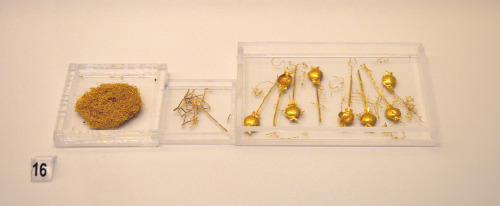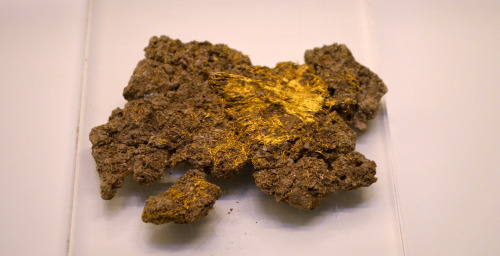Archaeological Museum of PatraGolden threads and sheets shaped like pomegranate fruit. From Patras H
Archaeological Museum of PatraGolden threads and sheets shaped like pomegranate fruit. From Patras Hellenistic Period. (3rd - 2nd cent. B.C)Oddments of golden threads, used for decorating luxury clothes. From Patras Hellenistic or Roman period.An even more difficult thing than ancient objects of wood to be preserved, are fibers, textiles and clothes. These two pieces of purple and gold textile that wrapped the bones of a young woman, theorized to be princess Meda, are one of the very few surviving pieces of fabric. The photography of this object is by Socrates Mavrommatis.However gold-sheet decorations of clothes* are frequently preserved, and we have several such finds even from the Bronze Age. In the collection of the Archaeological Museum of Patras, these artifacts are from the rich burial of a young woman, found in a cist grave in the Northern Cemetery of Patras, dating from the Hellenistic Period (150-125 B.C), and constituted part of her dress.From the museum tag:The young woman, who was a member of the social upper class, had an exceptionally rich burial. Her skeleton, 1.40m. in length, was laid out in an extended position and most of the grave offerings were found where they had originally been placed. The diadem was found on the forehead, beside the skull was a silver comb, on the lower jaw the danake, next to the skull the cupid earrings and on the chest the necklaces. The radial pectoral ornament was found on the breast and over it the pectoral band. The four multi-spiral rings were placed on the right hand and next to it the iron scraper with the remains of a silver sheet. The bronze mirror was laid in the centre of the pelvis, while there were gold threads from a garment on the chest, the breast and the lower legs.A closer look at the two pectoral ornaments. The banded ornament depicts a young man, possibly Hermes, and the ornament on the right depicts a scene of Hercules and the Hydra, as well as gorgon heads (on the four disks surrounding the central medallion). There was also a diadem depicting a Nike killing a bull.*This gold sheet jewellery is also theorized to be exclusively funerary in character, because of the recurrent themes, and the fast embossing method that was used to create the elaborate scenes.A similar burial can be found in the Archaeological Museum of Arta. It’s pretty impressive to see the amount of wealth that is often buried with a person, and it might indicate that this person could have suffered an untimely end, a young woman, probably a daughter of a rich family whose death would leave her relatives grief-stricken. The precious objects buried with her could be parts of her future dowry, and as she was never to be married and have children of her own to pass these objects on, they would accompany her to her final resting place.What was of particular interest for me was the placement of the box mirror onto the pelvis of the deceased, and I would like to find out if that was a common practice. Bronze mirrors are objects of particular aesthetic beauty, one of my favorite has a scene of two women bathing each other, and I would like to find out if they were associated with special qualities, or magical powers. The pelvis of a woman was also a special place associated with fertility and sexual health and in recent times, decorated aprons that would go over a woman’s traditional clothing would have the magical function of warding her from harm. —————-Finance more museum travelling, and a good supply of caffeinated drinks here: https://ko-fi.com/isabia -- source link
Tumblr Blog : greek-museums.tumblr.com
#ancient greece#tagamemnon#ancient textiles#fibers#fabrics#ancient fabrics#gold sheet#classical studies#archaeology#greek museums#museums#archaeological museums#greece#patra#ancient clothes#clothes

